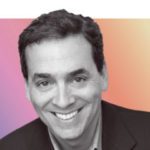 Kenji Haroutunian is vice president of Emerald Expositions and group show director for Outdoor Retailer (OR), an outdoor-sports trade show held biannually — Summer Market and Winter Market — at the Salt Palace Convention Center in Salt Lake City. This past Aug. 6-9, Summer Market drew nearly 27,000 attendees and 1,300 exhibitors, spread across 516,000 net square feet — 2.5 percent larger than OR’s 2012 Summer Market, and the largest OR show ever.
Kenji Haroutunian is vice president of Emerald Expositions and group show director for Outdoor Retailer (OR), an outdoor-sports trade show held biannually — Summer Market and Winter Market — at the Salt Palace Convention Center in Salt Lake City. This past Aug. 6-9, Summer Market drew nearly 27,000 attendees and 1,300 exhibitors, spread across 516,000 net square feet — 2.5 percent larger than OR’s 2012 Summer Market, and the largest OR show ever.
Haroutunian started with OR in 1999. “At that time,” he said, “the show was doing fine and growing steadily, but we fit in Salt Lake in a nice way.” Since then, the Salt Palace Convention Center has completed two significant expansion projects, in 2000 and 2005, the latter growing the venue to 679,000 square feet. And yet, Haroutunian said, “both of those times, by the time the construction had finished, we had already filled out the space.”
It’s a problem that most meeting planners and trade-show organizers would be happy to have — and yet it’s still a problem: too many attendees. What happens when a show that’s been fixed in one city for years, or has committed ahead of time to a building that can no longer contain it, starts to press at the limits of its chosen venue? What do you do? Or where do you go?
Limiting Attendance
One way that Outdoor Retailer has dealt with its growing pains is by taking steps to limit attendance. And if s chosen to do that by raising the bar on registration requirements for attendees from within drive-in distance, meaning that people without a natural barrier to attendance — such as the necessity of buying a plane ticket — have to meet more stringent requirements. OR’s logic is that if you’re willing to fly in, if s more likely that you’re not just coming to gawk at the latest in outdoor gear. “We have gotten more aggressive with improving the quality of attendance on behalf of exhibitors who are paying for the show,” Haroutunian said, “by keeping out those who aren’t really qualified to attend.”

This practice isn’t unique to OR. In fact, it’s a step that the ever-popular International Consumer Electronics Show (CES) — which is always held at the Las Vegas Convention Center, and in 2013 drew more than 152,000 attendees — also has taken. According to a spokesperson for the show, “All International CES attendees must verify and show proof that they work in the technology industry or related industries.”
Outdoor Retailer works with officials from Visit Salt Lake, the city’s DMO, to identify legitimate industry professionals who should be allowed to attend, “so that they aren’t garage bandits,” Haroutunian said, meaning home tinkerers or outdoor enthusiasts without much real buying potential. In addition, the show has its own registration team and registration partner company who work on qualifying attendees. Who is the ideal attendee for OR? Broadly speaking, buyers and other representatives from outdoor retail stores. Even attendees based in or around Salt Lake City who have been on the registration list for a long time in some cases have been asked to re-qualify. “Maybe it passed muster five years ago,” Haroutunian said, “but it might not now.”
As for non-local attendees — anyone who must fly in to attend — Haroutunian isn’t as worried about screening them. The cost of getting to the show is enough of a deterrent for people who aren’t serious potential buyers. And while OR hasn’t set a specific maximum number of attendees, exhibitors for the most part have responded favorably to the stricter registration requirements because they increase the average quality of attendee across the board.
Limiting attendance isn’t something many shows are keen to do, however — for obvious reasons. “I don’t think many shows would limit attendees, because that’s the lifeblood… for exhibitors,” said Hugh Easley, vice president of meetings and exhibitions for the National Association of College Stores (NACS), which in recent years has held its Campus Market Expo (CAMEX) — drawing an average of 2,100 attendees, not including exhibitor personnel — in Kansas City, Dallas, and Salt Lake. “You want to have the most attendees you can put through your show efficiently to provide ROI for more exhibitors.”
Limiting Exhibitors
While CAMEX might be unwilling to limit attendees, the show has reined in its exhibit hall, so that the ratio of exhibitors to attendees doesn’t drop too low. For the last five years or so, CAMEX has maintained its number of booths at about 1,550 to 1,600, balanced against total non-exhibitor attendance most recently, at the Kansas City Convention Center this past February, of 2,578.
One way to keep the number of exhibitors in check is through an invitation-only policy, as several groups that Lawson Hockman, vice president of association services at IMN Solutions, has worked with have done. “Vetting is done through the network,” Hockman said. “The groups I’ve worked with, they know the companies they want to do business with,” and they issue them a non-transferable invitation to attend the event. “Sort of like we get for [social] parties.”
But you have to be consistent when it comes to whom you do and don’t invite. “If you have five rules to be a member or an exhibitor,” Hockman said — such as not having any intellectual property violations, or any restrictions on doing business with the government — you can’t waive a rule. If you do, you leave yourself open to a lawsuit. Although the specific rules are particular to each group, the premise still applies. “If you change a rule for one,” Hockman said, “you have to notify other potential and present exhibitors that a rule has changed.”
You have to apply the same standards to awaiting list, as well — another way that max-capacity shows are able to contain demand and remain in their chosen venue. Indeed, for Sam Lippman, who as president of Lippman Connects produces the Exhibition and Convention Executives Forum (ECEF), the Large Show Roundtable, the Exhibit Sales Round-table, and the Attendee Acquisition Roundtable, a waiting list is the best option for “people who are wall-bound in convention centers.” When you are sold out, he said, “there is an excitement and energy that is positive for face-to-face events.” But of course it’s not all positive. “You are leaving money on the table,” Lippman said. “And as the waiting list grows, the possibility of a new splinter event being created with those waiting-list people grows.”
So how do you manage your waiting list? Lippman relates the story of the National Shooting Sports Foundation (NSSF). Three years ago, Chris Dolnack, NSSF’s senior vice president and chief marketing officer, “took the pretty bold move of disinviting an entire product category” from the organization’s annual 62,000-attendee SHOT (Shooting, Hunting, and Outdoor Trade Show and Conference), which for a “long, long time” now has been held at the Sands Expo Convention Center in Las Vegas. By doing so, Dolnack opened up exhibit space at the previously “wall-bound” show for new companies that attendees had been clamoring to see — as Dolnack knew from surveys that NSSF conducted — but couldn’t, because of space constraints.
There is expansion that is required and expansion that is desired.
Outdoor Retailer has taken a similar but less drastic step. According to Haroutunian, organizers very much need to curate a show — keeping all exhibitor categories in proper balance according to relative attendee interest — and sometimes must deny new companies from coming in because, for example, that particular product category might be saturated. “We also deny a lot of expansion requests,” he said, meaning an existing exhibitor that wants to increase its booth size — and pay more money to do so. Although Haroutunian hates walking away from that business, which has added up to 25,000 net square feet of denied expansion requests and $500,000 in revenue, he says he has to keep the attendee experience top of mind. “There is expansion that is required and expansion that is desired,” he said. “At the end of the day, we reserve the right to design the show for the attendees.”
Getting Creative With Space
Maximizing your available square footage is another way that a constrained show can avoid having to move. Robbi Lycett, vice president of conventions and conference for the Biotechnology Industry Organization (BIO), says that the BIO International Convention, which rotates venues each year — next year’s show will be held June 23-26 at the San Diego Convention Center — is “kind of bursting at the seams in a couple of facilities.” This past April in Chicago, BIO drew 13,594 attendees.
While BIO hasn’t reached “the fire marshal’s maximum like Comic-Con might do in San Diego,” Lycett said, it has run into the problem of not having enough exhibit space to sell, which hurts revenue and as a result negatively affects BIO’s lobbying and advocacy efforts. To address that, BIO has transformed a 30-foot-by-40-foot area in the center of the show floor into a business forum, with two-foot-by-three-foot conference rooms where exhibitors can meet one-on-one with attendees who request appointments via a partnering system that BIO makes available to exhibitors.
For the Healthcare Information and Management Systems Society’s (HIMSS) Annual Conference & Exhibition, space constraints “have come up a few times,” said Karen Malone, HIMSS’s vice president of meeting services, “when we were committed to a city, and we knew that we were going to run short or very tight on space but wanted to maintain our commitment to the city.” That happened at HIMSS 2013 in New Orleans this past March. “At the time we booked [in early 2009],” Malone said, “we would have fit in absolutely fine.” But during the time in between committing to the convention space and the show dates, not only did the HIMSS show change, nearly doubling its exhibitors since the last time the show had met in New Orleans, in 2007 — from 889 exhibitors to nearly 1,300, and from 24,081 attendees to just under 35,000 — the New Orleans Ernest N. Morial Convention Center changed as well, adding a ballroom but reducing its total exhibit-hall square footage.
“We had to go back to the drawing board,” Malone said. She and her team thought about how they could not only move some things that were typically in the exhibit hall to other parts of the building, but also “re-engineer” the show’s education schedule, so they could “lighten up on meeting space” and shift some of that square footage over to exhibitors. Eventually they moved HIMSS 2013’s 40,000-square-foot Interoperability Showcase, devoted to health-care information technology, off the show floor and onto the meeting-room level upstairs. Malone was nervous about the switch, because the showcase had “always had great foot traffic,” but she felt HIMSS had no choice. “We needed to free up some exhibit space to meet the demand of exhibitors who wanted to be on the floor,” Malone added.
To mitigate the expected drop in foot traffic through the Interoperability Showcase, Malone and her team created a “thoroughfare” through the area, running between one set of meeting rooms and another, so attendees were compelled to traverse it. The education schedule also used fewer concurrent rooms. To compensate, HIMSS ran more time blocks. “We had always been a show where we tried not to run the exhibit hall against educational sessions,” Malone said. “But we have come to believe, with the size of our show, we can no longer use half of the building at a time.”
HIMSS tested out another innovation in 2012, when it met at the Sands Expo Convention Center. For exhibitors who registered in the last 30 days before the show opened, HIMSS created a 3,000-square-foot area of kiosks on the show floor where they received a stand-up highboy station with two chairs where they could talk to clients. Exhibitors who purchased space in the kiosk area had mixed feelings about the setup. HIMSS tried to draw attendees to the area with F&B, but it was “a little difficult to see,” Malone said. Nevertheless, the area was able to accommodate three times more exhibitors than it would have if everyone had had a standard 10-foot-by-10-foot booth.
Working With Venues
San Diego’s Comic-Con International has become the poster child for what can happen when an event gets too popular. In 2010, the 125,000-attendee show, which has been held in San Diego for more than four decades, started to discuss its space challenges at the San Diego Convention Center — specifically, the fact that, in the midst of soaring popularity, it didn’t have any room for expansion. “We didn’t have any,” said Joe Terzi, president and CEO of the San Diego Tourism Authority (SDTA). “They take every square foot of the building.”
Wanting to keep the marquee event in its city, SDTA facilitated negotiations with Comic-Con’s hotel committee and most of the major hotels attached to or associated with the convention center. The hotels agreed to commit meeting space to allow Comic-Con to grow while the convention center works on a $520-million, 740,000-square-foot expansion project that was approved last month by the California Coastal Commission and is scheduled to be completed by 2018. The good thing, though, Terzi said, is that even under the current, pre-expansion configuration, “you can go from the Hilton [San Diego Bayfront] to the convention center in less distance than from one end of McCormick [Place] to the other.”
 |
But some shows, such as Haroutunian’s Outdoor Retailer, don’t have a wide variety of nearby convention hotels to expand into. Instead, they have to create “tent cities” in parking lots or other ancillary areas of the convention center property. It’s not as desperate as it sounds. Salt Lake has been a “really helpful partner” in helping construct external space, Haroutunian said — something the city might not be quite as willing to do if it were a first-tier meeting destination like Las Vegas or Chicago. Last year, Outdoor Retailer built some 150,000 square feet of exhibit space outside the Salt Palace Convention Center, with high-quality wood flooring, steel beams, air conditioning, and “proper lighting,” Haroutunian said. The area is called the “Pavilions at OR,” and historically — for three years now, since the program’s inception — has been where new exhibitors are featured. Some big, established vendors, such as Dickies and Mountain Khakis, also prefer to exhibit in the Pavilions, Haroutunian said, “because they can get the footprint and configuration that they want and couldn’t get in the main hall.”
Planning Ahead
In exhibitions as in sports, the best defense is a good offense. In that spirit, one thing that show organizers can do, whether meeting in San Diego or Salt Lake, is to plan ahead, and be aware of what their space needs might be not just next year or the year after, but even five years in advance. “How can we make a plan for the next five years, laying out primarily our exhibition floor?” Malone asked. “We started doing that over the last year or two, and are finding that to be much more effective, as we are trying to anticipate our needs for the future.”
Sometimes that could mean leaving your chosen venue, much as it might pain you to end a long city-based tradition. Terzi noted that HIMSS has decided to go to Las Vegas for a couple of the contract years they were talking with San Diego about, as has the Society for Human Resource Management (SHRM). HIMSS had been considering 2016 and 2018 — but they “outgrew even our expansion exhibit floor,” Terzi said. Malone confirms that. “In 2012 we had our meeting in Las Vegas and had terrific attendance,” she said. “We realized it was a very viable option from San Diego, whose exhibit space, even with the expansion, is 100,000 square feet shy of what we need.”
Meanwhile, Lisa Block, SHRM’s vice president of meetings and conferences, said that, while her organization was able to “make it work” at the San Diego Convention Center in 2010, “given our projected growth, we cannot commit to returning to a convention center that limits us.” It’s unfortunate because, as Terzi said, “They love the destination, but have decided they don’t have enough space.”
Test Time
Then go to pcma.org/convene-cmp-
The Certified Meeting Professional (CMP) is a registered trademark of the Convention Industry Council.



